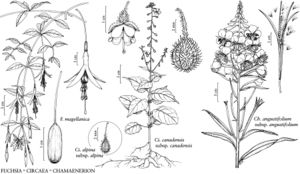Circaea canadensis subsp. canadensis
Herbs glabrous, glandular puberulent distally; stolons not tipped by tubers. Stems 20–90 cm. Leaves: petiole (1.3–)2.5–5.5 cm; blade narrowly to broadly ovate or oblong-ovate, 5–16 × 2.5–8.5 cm, base cordate to rounded, margins denticulate, apex acute to slightly acuminate. Inflorescences 2.5–30 cm. Flowers opening after elongation of axis, ± loosely spaced; pedicels spreading at anthesis, 2.5–6.5 mm, with a minute, setaceous bracteole at base; floral tube (0.4–)0.7–1.2 mm, funnelform, nectary projecting 0.2–0.7 mm beyond opening of floral tube; sepals green or purple, broadly elliptic or oblong to oblong-ovate, 1.9–3.8 × 1.2–2.4 mm; petals usually white, rarely pink, broadly deltate to broadly obovate, obcordate, or broadly obovate, (1.3–)1.6–2.9 × (1.5–)2.2–4 mm; apical notch 1/3 to slightly more than 1/2 length of petal; filaments 1.2–2.8 mm, pollen highly fertile (greater than 80%); style 2.5–5.5 mm, stigma surrounded by anthers at anthesis. Capsules pyriform to subglobose, rounded, usually obliquely, to pedicel, with corky, prominent ribs and deep grooves, 2.8–4.5 × 1.9–3.6 mm; pedicel and mature fruit combined length 6.3–11.2 mm. 2n = 22.
Phenology: Flowering summer.
Habitat: Cool, temperate deciduous and mixed forests, forest margins, along streams.
Elevation: 0–600 m.
Distribution
Cool, temperate deciduous and mixed forests, forest margins, along streams, Man., N.B., N.S., Ont., P.E.I., Que., Ala., Ark., Conn., Del., D.C., Ga., Ill., Ind., Iowa, Kans., Ky., La., Maine, Md., Mass., Mich., Minn., Miss., Mo., Nebr., N.H., N.J., N.Y., N.C., N.Dak., Ohio, Okla., Pa., R.I., S.C., S.Dak., Tenn., Vt., Va., W.Va., Wis.
Discussion
Subspecies quadrisulcata (Maximowicz) Boufford, which closely resembles subsp. canadensis, is in eastern Asia, extending from Japan across Russia to the vicinity of Moscow (D. E. Boufford 1982b). The presence of a minute bracteole at the base of the pedicel in subsp. canadensis is the only consistent feature that separates it from subsp. quadrisulcata, although subsp. canadensis tends to be somewhat larger overall.
Selected References
None.
